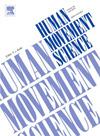Influence of exercise-induced hamstrings fatigue on proprioceptive reweighting strategies and postural performance in bipedal stance in recreational athletes
IF 1.9
3区 心理学
Q4 NEUROSCIENCES
引用次数: 0
Abstract
Objective
An optimal proprioceptive reweighting strategy is necessary to maintain posture. A suboptimal strategy was associated with injury determinants and whether the strategy can be modified is unknown. Muscle fatigue can be used to investigate proprioceptive reweighting. The aims of this study were to evaluate the effects of local fatigue on proprioceptive reweighting strategies and postural stability as well as relationships between fatigue and these postural parameters.
Design
Fourteen recreational athletes were included. Relative proprioceptive weighting (RPW) was characterized according to the perturbation of the center of pressure (CoP) displacement generated by muscle vibration on a firm and foam surface. RPW evolution <95 % indicated that individuals were able to reweight proprioception from the ankle to lumbar signals according to the surface while evolution >105 % indicated that athletes maintained an ankle-steered strategy. Student's t-tests were used to compare RPW evolution, CoP velocity, and root mean square (RMS) before and after exercise-induced hamstring fatigue. Spearman's rank correlation coefficient was used to test the relationship between fatigue variables, RPW evolution, and stability variables.
Results
Hamstring fatigue induced an ankle-steered strategy characterized by an increase in RPW evolution when the surface was changed (P = 0.002) and an increase in CoP velocity (P = 0.045) and CoP RMS (P = 0.005) on firm surface. None of the correlation coefficients testing the relationship between the parameters proved to be significant.
Conclusion
Local fatigue leads to suboptimal proprioceptive reweighting strategies and impaired stability on firm surface. Results suggests that proprioceptive reweighting strategies are modifiable. Whether this predisposes participants to injury remains to be defined.
运动引起的腿筋疲劳对休闲运动员本体感觉重配策略和双足站立姿势表现的影响。
目的:维持姿势需要最佳的本体感觉再平衡策略。次优策略与受伤的决定因素有关,而该策略是否可以改变还不得而知。肌肉疲劳可用于研究本体感觉重新配重。本研究旨在评估局部疲劳对本体感觉重新配重策略和姿势稳定性的影响,以及疲劳与这些姿势参数之间的关系:设计:研究对象包括 14 名休闲运动员。根据肌肉振动在坚硬泡沫表面产生的压力中心(CoP)位移扰动,对相对本体感觉配重(RPW)进行表征。RPW 演变为 105% 表明运动员保持了以脚踝为中心的策略。在运动引起腿筋疲劳前后,采用学生 t 检验比较 RPW 变化、CoP 速度和均方根(RMS)。斯皮尔曼等级相关系数用于检验疲劳变量、RPW变化和稳定性变量之间的关系:结果:腘绳肌疲劳诱发了以脚踝为中心的策略,其特点是当表面发生变化时,RPW 演变增加(P = 0.002),在坚硬表面上,CoP 速度(P = 0.045)和 CoP RMS(P = 0.005)增加。测试参数之间关系的相关系数均不显著:结论:局部疲劳会导致本体感觉配重策略达不到最佳水平,并损害在坚硬表面上的稳定性。结果表明,本体感觉配重策略是可以改变的。这是否会导致参与者受伤仍有待确定。
本文章由计算机程序翻译,如有差异,请以英文原文为准。
求助全文
约1分钟内获得全文
求助全文
来源期刊

Human Movement Science
医学-神经科学
CiteScore
3.80
自引率
4.80%
发文量
89
审稿时长
42 days
期刊介绍:
Human Movement Science provides a medium for publishing disciplinary and multidisciplinary studies on human movement. It brings together psychological, biomechanical and neurophysiological research on the control, organization and learning of human movement, including the perceptual support of movement. The overarching goal of the journal is to publish articles that help advance theoretical understanding of the control and organization of human movement, as well as changes therein as a function of development, learning and rehabilitation. The nature of the research reported may vary from fundamental theoretical or empirical studies to more applied studies in the fields of, for example, sport, dance and rehabilitation with the proviso that all studies have a distinct theoretical bearing. Also, reviews and meta-studies advancing the understanding of human movement are welcome.
These aims and scope imply that purely descriptive studies are not acceptable, while methodological articles are only acceptable if the methodology in question opens up new vistas in understanding the control and organization of human movement. The same holds for articles on exercise physiology, which in general are not supported, unless they speak to the control and organization of human movement. In general, it is required that the theoretical message of articles published in Human Movement Science is, to a certain extent, innovative and not dismissible as just "more of the same."
 求助内容:
求助内容: 应助结果提醒方式:
应助结果提醒方式:


